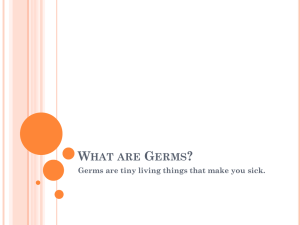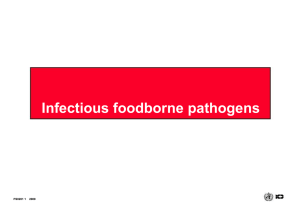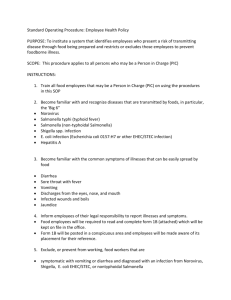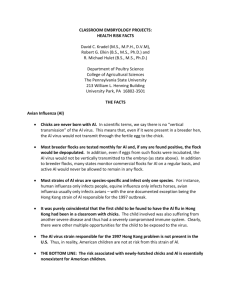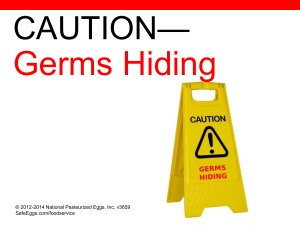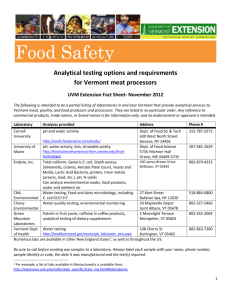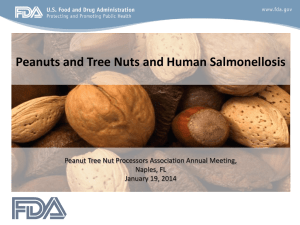Food Safety Inservice Presentation (editable PowerPoint file with
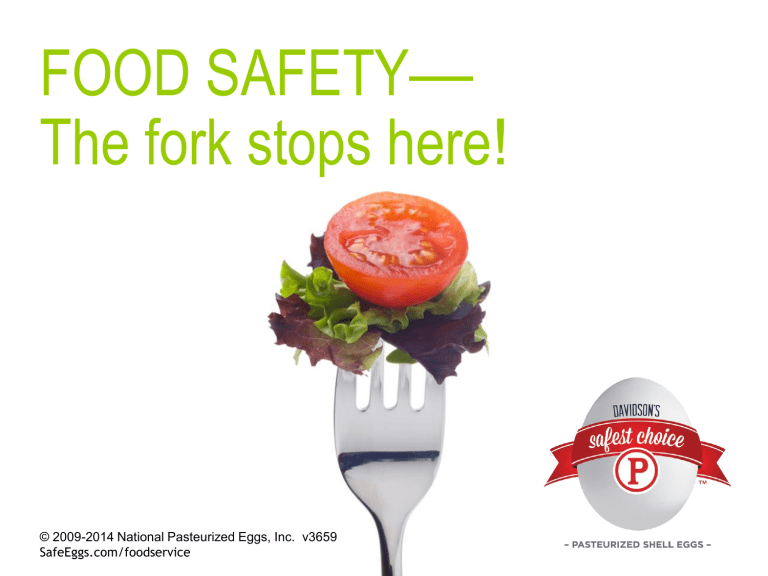
FOOD SAFETY —
The fork stops here
!
© 2009-2014 National Pasteurized Eggs, Inc. v3659
SafeEggs.com/foodservice
Recalls & Headlines - 2009
• Half a million pounds of ground beef recalled
28 sick, 2 deaths
• Nestles toll house cookies confirmed for the presence of E. coli – 69 people sickened, one mother fighting for her life
• JB Swift Beef Co. recalled beef products potentially contaminated with E. coli after 24 people being ill
Recalls & Headlines - 2009
• Serrano Peppers – Salmonella “ St. Paul ” over 1,300 people ill
• Sprouts recalled – Salmonella
• Iceless green onions – Salmonella
• Peanut Butter – Salmonella (2008-2009)
700 people sick, 9 died
400 products recalled
More than a number … .
76 million people sick
325,000 people hospitalized
5,000 people die
Foodborne illness costs the US up to $35 billion … but it ’ s not really about dollars.
From the Farm to the Fork!
Germs in soil & water
• Enter the food supply on the farm
• Or … in harvesting
• Or … in processing & packaging
• Or … in food service
Meet Typhoid Mary
• A cook in the early 1900s
• Had Salmonella in her body but was not sick
• Spread Salmonella through food she prepared
• Infected more than 47 people (3 died)
• Improper handwashing spread the germs
• Lived many years in quarantine
What do you know?
• Can ’ t see, taste, or smell germs
• People usually get sick in 1 to 3 days, but it can be up to 6 weeks!
• Some people think they have “ the flu ”
• Symptoms: nausea, vomiting, diarrhea, fever, headache, body ache … even a sore throat
The “ 200 Club ”
There are more than 200 germs that can cause foodborne illness.
“ BAD GUYS ” :
Bacteria
Viruses
Parasites
Molds
Chemicals
Physical objects
Salmonella bacteria
Meet the Newcomers!
• Norwalk virus (Norovirus) – 1968 – school children & staff became sick in Norwalk, Ohio
• E. coli – 1982 – first linked to ground beef
• Listeria monocytogenes – became a serious concern in mid 1980s
• E. coli – 1992 – showed up in apple cider
• Clostridium botulinum – 1994 – in baked potatoes in El Paso
30 people sick
• Cyclospera (parasite) – Guatemalan raspberries – 1996
• Salmonella Newport – 2002 – new, antibiotic-resistant strain in ground beef – caused an outbreak
• E. Coli in spinach – 2006
200 people sick; $10 million in damage to our economy
Antibiotic Resistance
Many of today ’ s toughest germs are
“ antibiotic resistant ”
This means they were stressed and grew stronger
Globetrotters!
• Dangerous germs spread faster through food and people
• Now a global “ germ pool ”
“ Sam & Ella ’ s ” Top 5!
1 –
Food from unsafe sources
2 –
Undercooking food
3 –
Holding at wrong temperature
4 –
Contaminated equipment
5 –
Poor personal hygiene
What YOU Can Do
Keep cold food cold and hot food hot because: bacteria multiply quickly in the danger zone!
What YOU Can Do
Check final temperature with thermometer
(don ’ t eyeball it)
What YOU Can Do
• Clean & sanitize
• Wash your hands frequently & well
• Use gloves or utensils – no bare hands
• Prevent cross contamination (germs traveling) … clean and separate!
How do you hit a moving target?
• New germs
• Germs in new foods
• Worldwide “ germ pool ”
The Fork Stops Here!

